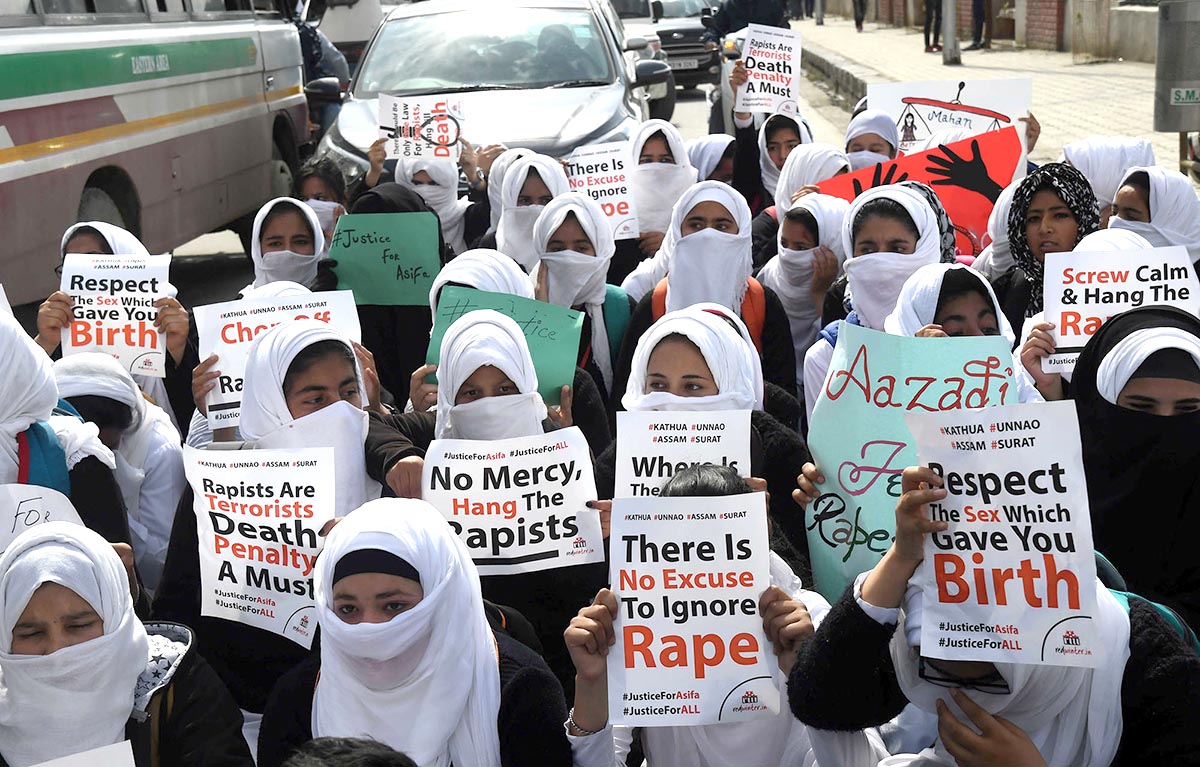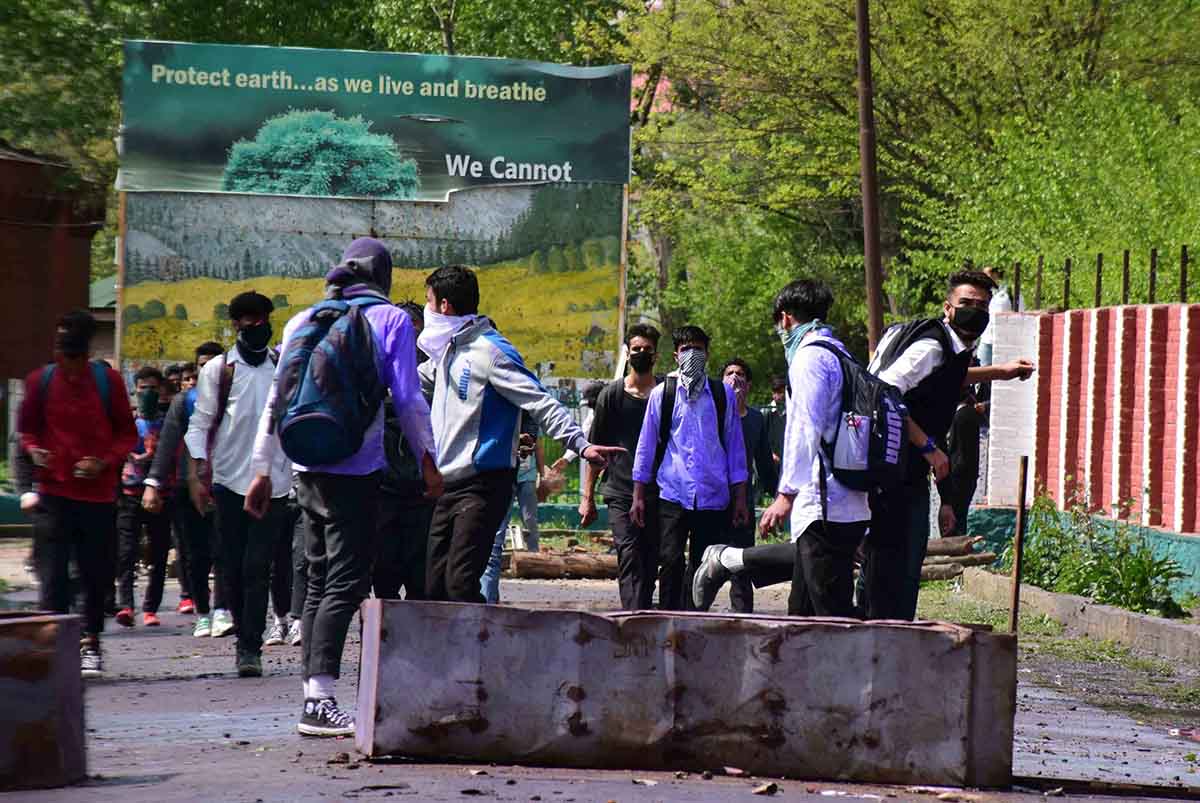In 47 days of schooling in Kashmir, classes were open for 24 days only. What it means for parents who spend hugely on education and Kashmir’s new generation that is growing up with little education, asks Umar Mukhtar

Abrar (name changed), 18, a student at senior secondary school Pulwama, leaves home early morning for tuitions, with a bag slinging on his shoulders. Soon after his tuitions are over, he heads for school. As he reaches the school gate, Abrar disappears in a small alley for a few minutes, goes behind the shop line, unzips his bag, pulls out his uniform and gets into the textbook schoolboy.
Abrar is actually evading the attention of the policemen deployed at different locations in the town. He was part of 2017 student protests. “A number of students were arrested while they were on their way to their schools and colleges. Our uniforms have become our enemies,” said Abrar. “I fear this uniform might land me in jail sometime.” This is the main reason why he carries his uniform in the bag.
This is a major shift in fast-changing Kashmir where the school uniform, once a guarantee of safety, is emerging as a symbol of vulnerability.
On April 12, 2017, after the army and the police stormed into the state-run degree college in Pulwama to arrest some boys accused for stone pelting, student across Kashmir reacted forcing authorities to close all the educational institution for a long time. Over two dozen students were injured that day and some of them with pellets even.
Pulwama raid was first of its kind of incident. It proved a game-changing event as it opened a new chapter in the campus unrest, a crisis still frequently recurs.
For managing the situation, authorities resorted to a slew of measures: early dates for examinations were announced, the syllabus was curtailed to offer relaxations.
But were these concessions required and does it go well with educating the new generation? It is still a debate within the academic policymakers.
But in the current academic session, it looks the thread has not been broken. In March the schools and colleges opened after the long winter break and students picked up what they had left when the winter vacations were announced: the protests. To counter this and not letting the education to be the ‘causality,’ there seems no alternative to the problem.
Authorities shut down most of the schools and colleges especially in Srinagar and South Kashmir calling it a ‘precautionary measure’ citing the reasons of law and order problem. A data with the school directorate reveals that in this session out of 47 days of active schooling, there was schooling for 24 days only.
This new phenomenon is something, which different people deconstruct with their own perspectives. There is a divide on this as well. Some people see it as ‘student activism’. A few call it ‘sheer madness.’
Student activism
Students taking part in the protests, though new to Kashmir, at least in last 30 years, is a global phenomenon. Invariably this leads to some changes.
But in Kashmir, student activism was never permitted. Probably this could be a factor that results in frequent protests. The campus unrest could be the outcome of chocking the activism space in the institutions.
Mehraj ud din, a student activist and scholar at the University of Kashmir calls it as liberation – a psychological liberation that is manifested on the roads. “Our space was chocked we were not able to speak our hearts out. This is always bound to happen when you try to suppress the voices.”
Many people think that choking of space for basic activism in campuses is a key factor in pushing individuals to pickup arms.
Kashmir University Students Union (KUSU) – a student’s body was formed in 2006, the only platform where students used to deliberate upon different issues through their activism. But in 2009 the body was banned and curtains fell on their activism.
Earlier in 1990, Islamic student’s league (ISL) was seen where students participated and did some activism but when the militancy broke out, it took a backseat. It became part of one side of Kashmir’s active ideological fault line and took a political stand.
But Mehraj voices his concern on the way students protest. Protesting against irregularities and against muzzling the dissent is fine but not at the cost of education. He blames teachers for such unsystematic uprising and terms it as ‘the failure of the teacher community.’
“When did you hear Kashmir University Teachers Association (KUTA) had come forward to protest and had taken a stand against something,” Mehraj questions. “Had the teacher community done so, they could have a moral high ground in convincing the student to get back to the classroom.”
In absence of formal student’s union body in the university and the colleges, space is open to being exploited by anybody. There are groups and sub-groups, which come to streets for something and have a different motive. Properly elected student bodies will inculcate the spirit of leadership, democracy and responsibility. Why are top politicians so keen to go and address the student body conventions in JNU and AMU?
Concerns
Nazir Ahmad, a senior lecturer, sees students taking part in protests as a positive change. But he is unhappy with the pattern – bunking of classes and coming on the roads and making it a routine.
This transformation, Nazir says, is not a reaction to many things that have accumulated over a long time and are snowballing into a crisis. “Students cannot read in the evening because they had to put off their lights to avoid any trouble. There are students in jails and many other facing trails,” Ahmad said.

Rarely reported, Kashmir periphery witnesses sort of black-out, mostly in villages. If the light is put on late in the night, it can lead to a knock by either of the two forces – the militants and the troops, who could be moving around. There have been very unpleasant events in the past, including one in which a boy, preparing for his examinations, was killed. Such situations, however, are not prevalent in the universities or in the main city and major towns.
A study Education and Unrest in Kashmir: The Way Forward by a Non-Governmental Organization (NGO), states that if the present scheme of things continue in the education sector amidst 2016 kind of unrest – closing of educational institutions citing law and order problems, the risk of extremism, wide-scale criminalization of youth, chronic unemployment, drug abuse, and psychological disorders as witnessed in other protracted conflicts around the world will engulf Kashmir.
The study also points out that majority of the students are in favour of the shutdowns and protests despite knowing that it would have a negative influence on their education. Only 25 percent students were against this. Their support for protest strikes stems from their political beliefs and the lack of belief in the education system, the report said.
Khursheed Ahmad, an assistant professor says that if this situation will not be addressed Kashmir should be ready to have an arrogant, education less and fragile community of youth. “We cannot let the political problems take a toll on education and no sensible society will allow that,” He said. “We have to balance it somehow.”
The only positive that we could induce to our system was community schooling earlier in 2016 when the curfew was imposed for consecutive 53 days and then in 2017 when student uprising took place. Reportedly, some NGO’s want to establish such schools in those parts where such circumstances prevail.
Meanwhile the education department in Kashmir claim of devising an academic calendar to balance any loss of academic activities due to law-and-order problems and other unforeseen circumstances this year. But on the ground, the old mechanism seems to be in place.
Nobody seems to be bothered about the material costs it entails. No school has ever offered any kind of concession to the parents for the day’s schools were locked. They say they have to pay the staff. And they even charged the transport costs. Reason: we have to pay the banks because the availability of transport is linked to the admissions!
In the entire game, the population is facing on two counts. They spend what they are supposed to: almost Rs 2000 crore a year. Still, they are unable to have their wards educated, properly. Is it going to trigger a new trend of sending kids outside Kashmir?
from Kashmir Life https://ift.tt/2HrcEGW
via IFTTThttps://kashmirlife.net
No comments:
Post a Comment